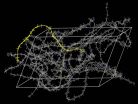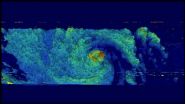(Press-News.org) Australian researchers have shown why calcium-binding drugs commonly used to treat people with osteoporosis, or with late-stage cancers that have spread to bone, may also benefit patients with tumours outside the skeleton, including breast cancer.
Several clinical trials – where women with breast cancer were given these drugs (bisphosphonates) alongside normal treatment for early-stage disease – showed that they can confer a 'survival advantage' and inhibit cancer spread in some women, although until now no-one has understood why.
A new study by Professor Mike Rogers, Dr Tri Phan and Dr Simon Junankar from Sydney's Garvan Institute of Medical Research has used sophisticated imaging technologies to reveal that bisphosphonates attach to tiny calcifications in tumours in mice.
These calcium-drug complexes are then devoured by 'macrophages', immune cells that the cancer hijacks early in its development to conceal its existence.
The study, which includes remarkable movies of the entire process described above, is published in the prestigious journal Cancer Discovery, now online.
The authors, who also analysed tissue samples from cancer patients, believe that the findings are relevant to people.
"We do not yet fully understand how the macrophages revert from being 'bad cops' to being 'good cops', although it is clear that this immune cell interacts with tumours, and probably changes its function in the presence of bisphosphonates," said project leader Professor Mike Rogers.
"The surprising thing is that we didn't make the connection between bisphosphonates and tumour calcifications before - of course bisphosphonates are going to bind to calcium! It had been staring us in the face for a long time, yet we didn't explore that action of the drug. Perhaps because there is such strong acceptance that these drugs only work in bone."
"When we showed our movies at a conference recently, you could have heard a pin drop in the room - at the same time as the penny dropped for the audience."
Colleague Dr Tri Phan, an immunologist and microscopist, commented that he did not think such a process could be possible until he saw it with his own eyes.
"I clearly remember the moment we first saw macrophages behaving like little Pacmen and gobbling up the drug. It was astounding," he said.
"Our next step will be to analyse the changes that take place in macrophages, so that we can understand their change in function, and effect on cancer cells."
Once Rogers and his colleagues realised what was happening in mice, they worked with colleagues at St Vincent's Hospital in Sydney, and obtained a tumour sample from a patient with breast cancer who had undergone surgery. They stained the tissue for calcifications, and found them next to and even inside macrophages, indicating that the same process happens in humans.
"This study is potentially transformative for treatment of some cancers, because it is telling us for the first time that drugs we thought acted only in bone can also act within tumours completely outside the skeleton, and have a beneficial effect," said Professor Rogers.
"We already know this drug is well-tolerated in people and provides a survival advantage for some patients with certain cancers when taken early in disease development. This now provides a rationale for using these drugs in a different, and potentially more effective, way in the clinic."
INFORMATION:
Researchers from the University of Cambridge have identified a class of low-cost, easily-processed semiconducting polymers which, despite their seemingly disorganised internal structure, can transport electrons as efficiently as expensive crystalline inorganic semiconductors.
In this new polymer, about 70% of the electrons are free to travel, whereas in conventional polymers that number can be less than 50%. The materials approach intrinsic disorder-free limits, which would enable faster, more efficient flexible electronics and displays. The results are published today ...
CHICAGO (November 5, 2014) – When wildfire and people intersect, it is often in the wildland-urban interface, or WUI, a geography where homes, roads and trails intermix with fire-prone vegetation. In an article published Thursday in the journal Nature, U.S. Forest Service scientist Sarah McCaffrey and her colleagues advocate for an approach to wildfire management that reflects ecological science as well as research on the human dimensions of wildfire and fire management.
"Learning to Coexist with Wildfire," a research review led by the University of California-Berkley, ...
PHILADELPHIA –A diagnosis of septic shock was once a near death sentence. At best, survivors suffered a substantially reduced quality of life.
Penn Medicine researchers have now shown that while most patients now survive a hospital stay for septic shock, 23 percent will return to the hospital within 30 days, many with another life-threatening condition -- a rate substantially higher than the normal readmission rate at a large academic medical center. The findings are published in the new issue of Critical Care Medicine.
"Half of patients diagnosed with sepsis ...
November 5, 2014 – Insomnia is a "prevalent and persistent" problem for patients in the early phases of recovery from the disease of addiction—and may lead to an increased risk of relapse, according to a report in the November/December Journal of Addiction Medicine, the official journal of the American Society of Addiction Medicine. The journal is published by Lippincott Williams & Wilkins, a part of Wolters Kluwer Health.
"Treating sleep disturbance in early recovery may have considerable impact on maintenance of sobriety and quality of life," according ...
Despite great advances in understanding how the human brain works, psychiatric conditions, neurodegenerative disorders, and brain injuries are on the rise. Progress in the development of new diagnostic and treatment approaches appears to have stalled. In a special issue of the Cell Press journal Neuron, experts look at the challenges associated with "translational neuroscience," or efforts to bring advances in the lab to the patients who need them.
"A variety of global impact studies have identified brain disorders as a leading contributor to disabilities and morbidity ...
DENVER – A risk stratification model based on lymph node characteristics confirms with a high level of confidence the true lack of lung cancer in lymph nodes adequately sampled with endobronchial ultrasound-guided transbronchial needle aspiration and classified as negative.
Lung cancer treatment and prognosis is critically dependent on accurate staging that takes into account the extent to which cancer has spread from the primary lung tumor to other locations. Examination of lymph nodes containing lung cancer cells that have spread can be done by surgical removal, ...
Stanford University School of Medicine scientists have found a new way to forecast which patients with age-related macular degeneration are likely to suffer from the most debilitating form of the disease.
The new method predicts, on a personalized basis, which patients' AMD would, if untreated, probably make them blind, and roughly when this would occur. Simply by crunching imaging data that is already commonly collected in eye doctors' offices, ophthalmologists could make smarter decisions about when to schedule an individual patient's next office visit in order to optimize ...
Hurricane Vance was a hurricane on Nov. 4 when the Tropical Rainfall Measuring Mission or TRMM satellite and the Global Precipitation Measurement (GPM) mission satellite passed overhead and measured its rainfall from space. TRMM and GPM revealed areas of heavy rain within the storm before it weakened to a depression and made landfall on Nov. 5.
The TRMM satellite flew over hurricane Vance on Nov. 4 at 0953 UTC (4:53 a.m. EST). Rainfall derived from TRMM's Microwave Imager (TMI) data collected were overlaid on a 1000 UTC (5 a.m. EST) image from NOAA's GOES-West satellite ...
Typhoon Nuri continued moving in a northeasterly direction passing the island of Iwo To, Japan when NASA's Aqua satellite passed overhead.
The Moderate Resolution Imaging Spectroradiometer or MODIS instrument that flies aboard NASA's Aqua satellite captured a visible picture of Typhoon Nuri on Nov. 5 at 4:10 UTC (11:10 p.m. EST, Nov. 4).
At 1002 UTC (5:02 a.m. EST) a microwave image captured from NASA/JAXA's Tropical Rainfall Measuring Mission or TRMM satellite showed that the low-level center of circulation was beginning to weaken. The strongest thunderstorms had become ...
DENVER – Pretreatment interstitial lung disease (ILD) is a significant risk factor for developing symptomatic and severe radiation pneumonitis in stage I non-small cell lung cancer (NSCLC) patients treated with stereotactic body radiation therapy (SBRT) alone.
ILD is a group of diseases that cause scarring and stiffing of the tissue and space around the air sacs in the lungs, which results in diminished gas exchange. The incidence of ILD among lung cancer patients is higher than in the general population as tobacco smoking is a common risk factor for both. Some ...



